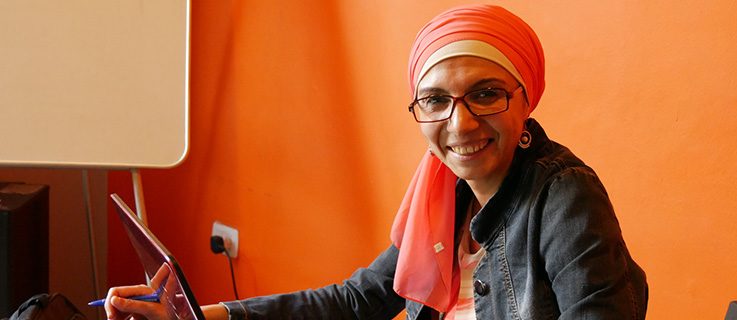A Jordanian journalist teaches Hebrew to her compatriots. There is a lot of interest in the neighbor’s language in Amman, yet classes are hard to find.
Her bright apricot-colored hijab is tied casually in the back and perfectly matches the floral pattern of her dress. As she opens her notebook, she flashes a girly grin behind a stylish pair of glasses. Rania El-Jaabari is a woman who knows what she wants. Her day job is political editor for a Lebanese newspaper. In her free time, she is a language teacher. Her lesson is about to begin.
The 36-year old Jordanian teaches Hebrew, which is not exactly a common occurrence in Amman. Classes in this language are almost impossible to find, even though Jerusalem is not even 80 kilometers from the Jordanian capital of Amman.
When Rania decided to learn her neighbors’ language about eight years ago, it took her a long time to find a class. Incredulous friends asked her why she wouldn’t rather brush up on her English or learn French. But Rania’s rather unusual decision was inspired by a fluent Hebrew-speaker, a colleague at the Lebanese newspaper where she works as political editor. “How are we ever going to understand what makes the Israelis tick if we don’t even speak their language?”
The shortage of Hebrew language classes, even now, 23 years after the official Jordan-Israel peace treaty, bothers Rania. In Egypt, which made peace with Israel in 1979, the Jewish neighbor is still a popular bogeyman, and yet Hebrew as a foreign language is in high demand along the Nile River. “In Egypt, but also in Jordan, curiosity about Israel trumps hatred,” says Rania. Arabs are trying to break the “Israel Code”, they want to understand what drives Israel, where it is headed.
A Hebrew-speaking community in Amman
Demand for Hebrew is immense, confirms Kristina Kaghdo of Jadal, an alternative event venue in Downtown Amman, which offers Rania’s language class as well as a variety of other recreational activities. More than 30 people registered for only eight spots in the class. There is a long waitlist, and a new class is scheduled to start in July, when the beginners from the current session move up to the advanced class. The Jadal attracts many international patrons, but the people interested in the Hebrew class are all Jordanians. Many are motivated by curiosity. “Some just want to add another language to their repertoire, some want to learn the differences between Arabic and Hebrew, some come because they need Hebrew for their job or to do business with Israelis,” Kristina Kaghdo explains.
Jadal is acutely aware of its responsibility, Fadi Amireh explains. The former construction engineer, fed up with office life before he even reached his thirties, founded the alternative cultural center at the famous Al-Kalha stairs almost four years ago. He would not let just anyone loose on a class of Hebrew learners. “We have a reputation to uphold,” he says. Kristina adds that in Jordan, you have to be careful not to come across as an advocate of Israeli policies. Despite the huge demand, they did not actively search for a Hebrew teacher. Rania volunteered herself when she and her two close acquaintances were having tea in the Jadal courtyard, thinking out loud about offering another language class.
For Rania, the gig has the welcome side effect of building a small Hebrew-speaking community she can converse with. For one big issue is the lack of Hebrew speakers with whom to practice, except for this one colleague who inspired her to learn the language in the first place. “Conversation beats listening to the radio any time,” she laughs. Yet she does also listen to Hebrew radio programs, reads Israeli newspapers, and translates short texts all the time.
Linguistically, Arabs and Israelis are true sisters
Now Rania is standing in front of her class. She is teaching the letters, of which there is a total of 22 in the modern Hebrew alphabet, associated with 25 different sounds. And while its phonetics is quite similar to Arabic – both languages are part of the same Semitic language family –, the letters are totally different. That means a lot of practicing, drawing lines, arches, and dots, until a word emerges. Rania is very patient with her students, for she wants them to enjoy the language. She also teaches them about the history of the language, the etymological roots of modern Ivrith, which is spoken in Israel today, and which starkly differs from the Hebrew of the Bible, for example.
If language were the only barrier dividing the Israelis on the one side and the Jordanians and Palestinians on the other, the Middle Eastern Conflict would have been resolved a long time ago. Linguistically speaking, they are truly sisters. The small language class at Jadal may be an exception, but it holds promise that an understanding between Hebrew-speaking Israelis and their Arabic-speaking neighbors might one day succeed.
Rania dismisses her students with a cheerful ‘Shalom!’ … which means peace.
